In Texas, there are twenty-eight salamander species. Salamanders in Texas include species from the families Ambystomatidae, Amphiumidae, Plethodontidae, Proteidae, Salamandridae, and Sirenidae.
While most salamanders resemble lizards, these amphibians come in many shapes and sizes. Some salamanders such as the three-toed amphiuma even look like eels and are often mistaken for eels. Also, salamanders are amphibians, unlike lizards which are reptiles.
Salamanders can be terrestrial, aquatic, or semi-aquatic. Some salamanders are even subterranean. There are many subterranean salamanders in Texas. These are tiny amphibians that live entirely in darkness in caves and caverns below ground.
Salamanders are amphibians found in the order Urodela.
Table of Contents
Salamanders in Texas
Family Ambystomatidae
1. Marbled Salamander
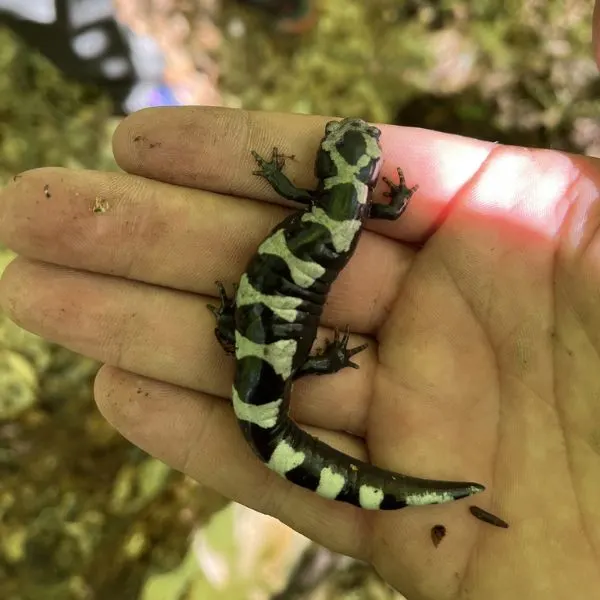
- Scientific Name: Ambystoma opacum
- Other Common Name: Banded salamander
- Average Adult Size: 3.5 to 4.25 inches (9 to 10.7 cm)
- Life Span: up to 8 years (average of 3.5 years)
- Population Trend: Stable
- Conservation Statuses: Least Concern on IUCN Red List, S5 (Secure)
A. opacum is one of the smaller Ambystomatids. This amphibian can reach a length of 4.25 inches from its head to the tip of the tail. Across the body, head and tail are whitish crossbands.
The crossbands of the species are whiter in males, especially during the breeding seasons. While males have whitish silver bands in males, females have grayish silver bands. The rest of the species is black.
The species is endemic to most of east Texas from the Gulf of Mexico north to the Red River. Outside of Texas, the species can be found throughout the entire eastern United States.
The geographic range of the species starts from New Hampshire to northern Florida and from southeastern New York to the Lake Michigan region to eastern Oklahoma and finally to the Gulf Coast.
Within the eastern United States, the species doesn’t occur in most of the Appalachian.
These amphibians make excellent pets.
2. Spotted Salamander
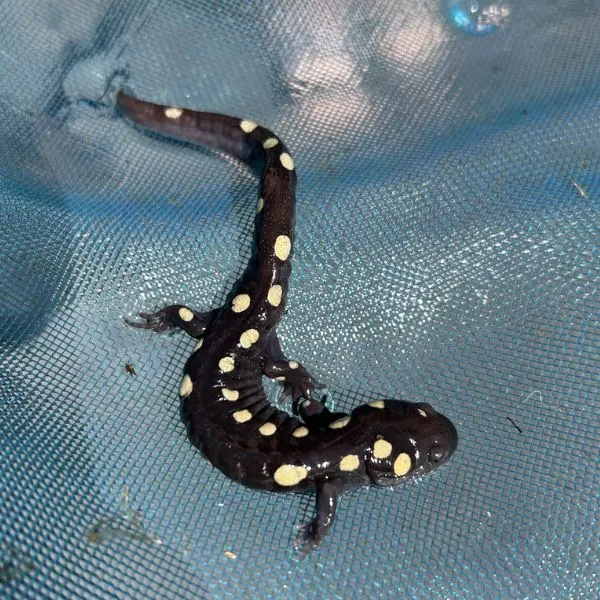
- Scientific Name: Ambystoma maculatum
- Common Name: Spotted Salamander
- Average Adult Size: 6 to 9.5 inches (15 to 24 cm)
- Life Span: 30 years in the wild, 25 years in captivity
- Population Trend: Stable
- Conservation Statuses: Least Concern on IUCN Red List, S4 (Apparently Secure)
The spotted salamander is known as the spotted salamander because of the spots on its body, these spots are yellow or orange on a dark background – black, dark grey, or dark brown. Each individual has about 20 to 45 spots that are arranged irregularly. There are unspotted morphs but these are hard to come by.
This species inhibits most of Texas and is commonly close to stagnant water such as ponds in mixed forests and hardwood forests.
The geographic range of the species encompasses most of the eastern United States. The species can even be found in southern Canada in provinces including Quebec, Prince Edward Island, Ontario, Nova Scotia, and New Brunswick. In the United States, the geographic range extends southward to southeastern Texas, and westward from the East Coast to eastern Iowa. The species is absent from Florida.
3. Mole Salamander

- Scientific Name: Ambystoma talpoideum
- Common Name: Mole salamander
- Average Adult Size: 3 to 4 inches (7.5 to 10 cm)
- Life Span: 10 to 20 years
- Population Trend: Stable
- Conservation Statuses: Least Concern on IUCN Red List, S3 (Vulnerable)
This salamander is tiny. It grows to be just 4 inches. This salamander is known to burrow underground thus their common name. While larvae are aquatic, adults may be aquatic or terrestrial.
Aquatic adults do not metamorphose and keep their larval form. Terrestrial adults metamorphose and look like regular salamanders. They are black in color.
This species is endemic to east Texas, specifically the Gulf Coastal Plain.
Outside of Texas, the species is endemic from the Coastal Plain of South Carolina to northern Florida. The geographic range extends to eastern Texas and Oklahoma.
The species can also be found as far north as Mississippi Valley, southern Indiana, and southern Illinois. The species also occur in Kentucky, Tennessee, Alabama, Georgia, North and South Carolina, and Virginia.
4. Smallmouth Salamander
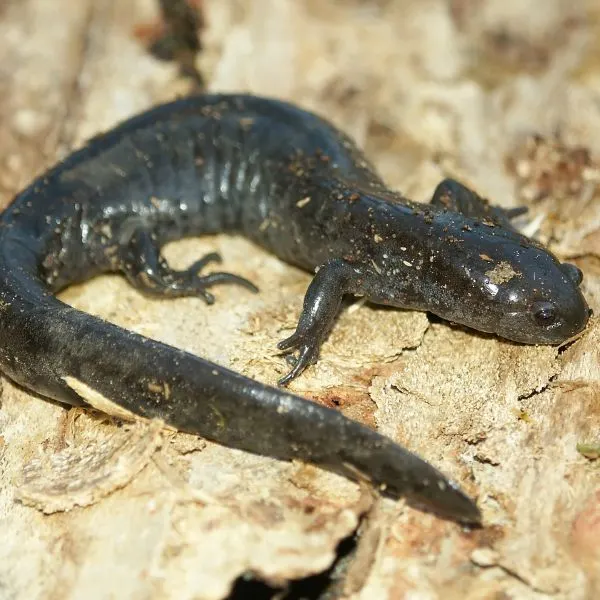
- Scientific Name: Ambystoma texanum
- Other Common Names: narrow-mouthed salamander, porphyry salamander, Texas salamander
- Adult Length: 4.5 to 7 inches (11.4 to 17.8 cm)
- Population Trend: Stable
- Conservation Statuses: Least Concern on IUCN Red List, S5 (Secure)
A. texanum is a moderately sized salamander that reaches an adult length of about 4.5 to 7 inches. This amphibian is dark brown or black in color. The head is quite small for its body and tail.
This species is endemic to eastern Texas. outside of Texas, the species is endemic to eastern Kansas, southern Iowa to the east to Alabama, central Tennessee, western Kentucky, western West Virginia. Ohio, Pelee Island in southwestern Ontario, and southern Michigan.
5. Eastern Tiger Salamander

- Scientific Name: Ambystoma tigrinum
- Common Names: Tiger salamander, eastern tiger salamander, tiger
- Average Adult Size: 6.6 to 13 inches (17 to 33 cm)
- Life Span: 25 years
- Conservation Statuses: Least Concern on IUCN Red List, S3 (Vulnerable)
A. tigrinum is stout with yellow markings on a dark background. These markings slightly resemble the fur of a tiger. This gives the salamander its common name.
Similar to the western tiger salamander, the eastern tiger salamander is endemic to most of Texas. The only part of Texas it is absent from is the eastern quarter.
Although more common in eastern North America, the species can be found in the Pacific Northwest as well. The geographic range of A. tigrinum extends from Manitoba in Canada to Mexico. From west to east, the species occur in Oregon and Washington to New York and south to Florida. The species occurs in most states in the United States.
The species is carnivorous as are all other salamanders. The species feed on insects, worms, slugs, and snails.
Keeping A. tigrinum as a pet is relatively easy. As pets, they accept baby snakes, mice, frogs, and other salamanders.
6. Western Tiger Salamander

- Scientific Name: Ambystoma mavortium
- Other Common Names: barred tiger salamander, blotched tiger salamander
- Average Adult Size: 6 to 14 inches (15 to 35.6 cm)
- Lifespan: 12 to 15 years
- Population Trend: Stable
- Conservation Statuses: Least Concern on IUCN Red List
A. mavortium is among the largest salamanders on earth. These amphibians can reach a length of 14 inches. This is a little over a foot. Ambystoma mavortium is known as a tiger salamander because of its yellow and black coloration. The background is black with yellow markings. The dorsum can also be light-grey.
The western tiger salamander is endemic to most of Texas. The only part of Texas it is absent from is the eastern quarter. The range of the species starts in southern Canada (where it occurs in Saskatchewan, Manitoba, British Columbia, and Alberta) to Puebla in Mexico. The species is endemic to western North America.
This amphibian may be kept as a pet.
Family Amphiumidae
7. Three-toed Amphiuma
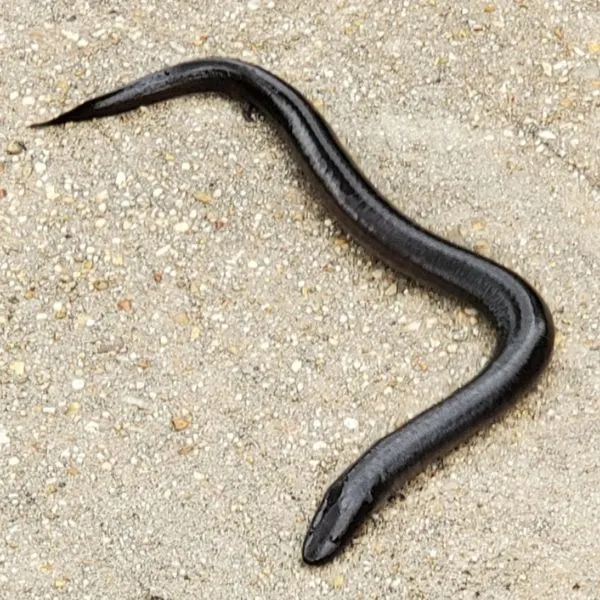
- Scientific Name: Amphiuma tridactylum
- Average Adult Size: 18 to 30 inches (46 to 76 cm)
- Life Span: 27 years
- Population Trend: Stable
- Conservation Statuses: Least Concern on IUCN Red List, S5 (Secure)
The species is native to east Texas. Outside of Texas, the species is endemic to Missouri, Kentucky, Oklahoma, Tennessee, Arkansas, Mississippi, Alabama, and Louisiana. The species is endemic to the southeastern United States.
A. tridactylum looks like an eel except for its tiny vestigial legs which have three toes. These legs are tiny and may be difficult to notice. The body of the species is grayish-black. The eyes are tiny and lidless. The species also have gill slits.
The three-toed amphiuma is aquatic.
Family Plethodontidae
8. Southern Redback Salamander

- Scientific Name: Plethodon serratus
- Other Common Names: Southern Red-Backed Salamander
- Average Adult Size: 3 to 4 inches (8 to 10.5 cm)
- Average Price Range: Approximately
- Population Trend: Stable
- Conservation Statuses: Least Concern on IUCN Red List, S1 (Critically Imperiled)
It is unknown if the species is still endemic to Texas as the only individual found was in 1940. This individual was found in Nacogdoches County. There are four distinct wild populations. These include the populations in central Louisiana; in eastern Alabama, Georgia, western North Carolina, and eastern Tennessee; the southeastern quarter of Missouri; and from eastern Oklahoma to Arkansas.
This is a small salamander with a red stripe across its back. This red stripe gives the species its common name. This stripe may be dark gray or light gray. The stripe usually has a serrated edge.
9. White-throated Slimy Salamander

- Scientific Name: Plethodon albagula
- Other Common Names: Western slimy salamander, whitethroat slimy salamander,
- Population Trend: Stable
- Conservation Statuses: Least Concern on IUCN Red List, S4 (Apparently Secure)
The species is black with white speckles. Some individuals have large white blotches on the side of their bodies along with tiny specklings on their backs. They also have long tails and large eyes.
The white-throated slimy salamander does not go through a larval phase. They come out of their eggs fully formed. Similar to other salamanders, P. albagula hides from humans and live in places that are very humid.
There are several genetically divergent and disjunct wild populations endemic to Texas (in the Balcones Escarpment area). These populations can be found in northeast, southeast, and central Texas.
Outside of Texas, the species occur in Missouri, Oklahoma, and Arkansas. In Missouri, the species is endemic to the south. In Arkansas, the species s endemic to the highlands of the west and the north. In Oklahoma, the species is endemic to the central and northern portions.
10. Southern Dusky Salamander

- Scientific Name: Desmognathus auriculatus
- Other Common Names: Holbrook’s Southern Dusky Salamander, eared triton
- Adult Length: 3 to 6 inches
- Population Trend: Stable
- Conservation Statuses: Least Concern on IUCN Red List, S1 (Critically Imperiled)
D. auriculatus is moderately sized and can reach a length of about 6 inches. The dorsum of the species is black or dark brown. It has a long tail, small front legs, and large rear legs. The rear legs are much larger than the front legs.
The once common southern dusky salamander is no longer common, especially in Texas. This species used to be common throughout its range in the southeastern United States.
Within Texas, the species is native to the Trinity River Basin. The species occurs across the southeastern United States. These include in states including Virginia, South Carolina, North Carolina, Mississippi, Louisiana, Georgia, Florida, and Alabama.
11. Cascade Caverns Salamander

- Scientific Name: Eurycea latitans
- Population Trend: Decreasing
- Conservation Statuses: Vulnerable on IUCN Red List, S2 (Imperiled)
This is an aquatic salamander that retains many juvenile characteristics even as an adult. For instance, adults still have external gills. E. latitans is translucent. It is brown with white specklings. Their bodies are stout and their limbs are small. Their tiny eyes are underneath a layer of skin. This species is rarely seen.
The species is endemic to the Cascade Caverns in central Texas. Eurycea latitans also inhabit other caves close to the Cascade Caverns. The species occur in southern Kendall County, northern Bexar County, and western Comal County.
The species live in caves and springs with water in limestones.
12. San Marcos Salamander

- Scientific Name: Eurycea nana
- Adult Length: 2 inches (5 cm)
- Population Trend: Stable
- Conservation Statuses: Vulnerable on IUCN Red List, S1 (Critically Imperiled)
E. nana is a tiny salamander. In fact, it may be the smallest salamander of the genus Eurycea. E. nana gores to just 2 inches although some individuals can be 3 inches. E. nana is lungless and has gill fringes that are noticeable even among adults. It is slender with 4 toes on the front legs and 5 toes on the rear legs.
In Texas, Eurycea nana inhabits Hays County, specifically the San Marcos River – (San Marcos Springs, Spring Lake. The geographic range of the species is about 8 sq-km.
13. Georgetown Salamander

- Scientific Name: Eurycea naufragia
- Other Common Names: San Gabriel Springs salamander
- Adult Length: 2 to 3 inches (5 to 7.5 cm)
- Population Trend: Decreasing
- Conservation Statuses: Endangered on IUCN Red List, S1 (Critically Imperiled)
The species is tiny reaching a length of 2 to 3 inches on average. Adults are dark olive, gray or dark brown in color with juveniles having a much darker color. They are also translucent.
Within the state, Eurycea naufragia inhabits the Edwards Plateau area in central Texas – specifically northeast of the Colorado River. The species is endemic to Williamson County. The geographic range of the species is calculated to be 22.9 sq-km.
14. Dwarf Salamander

- Scientific Name: Eurycea quadridigitata
- Other Common Names: southeastern dwarf salamander, Florida dwarf salamander, dwarf four-toed salamander, four-fingered manculus
- Adult Length: 2 to 3.5 inches (5 to 8.8 cm)
- Population Trend: Stable
- Conservation Statuses: Least Concern on IUCN Red List
The species is a tiny amphibian. It reaches a length of just 2 to 3 inches. The body is slender and the tail is long. The coloration and patterns of individuals vary. However, most are yellowish brown with dark blotches and dark strikes on the sides of their body.
Eurycea quadridigitata is endemic to east Texas.
15. Texas Blind Salamander

- Scientific Name: Eurycea rathbuni
- Adult Length: 3.25 to 5.375 inches (8.3 to 16.7 cm)
- Population Trend: Stable
- Conservation Statuses: Vulnerable on IUCN Red List, S1 (Critically Imperiled)
E. rathbuni live strictly underground. Although the species have eyes they are vestigial and are under a layer of skin. The head of the species is flat and broad. The species are lungless and have external gills which they use respire. Adults reach a length of about 5 inches.
This species is endemic to Hays County, specifically the San Marcos Pool in Edwards Plateau. The geographic range of the species is deemed to be 12 sq-km.
16. Salado Springs Salamander

- Scientific Name: Eurycea chisholmensis
- Other Common Names: Salado Salamander, Chisholm Trail Salamander
- Population Trend: Unknown
- Conservation Statuses: Vulnerable on IUCN Red List, S1 (Critically Imperiled)
The species is aquatic and live in the immediate vicinity of spring outlets. They also breed in water. They can be found in gravels and under rocks in spring outlets.
In Texas, Eurycea chisholmensis inhabits the Edwards Plateau area in central Texas – specifically northeast of the Colorado River. The species occur in 19 places within Bell and Williamson Counties. The geographic range of the species is about 190 sq-km.
17. Barton Springs Salamander

- Scientific Name: Eurycea sosorum
- Adult Length: 2.5 inches (6.35 cm)
- Population Trend: Stable
- Conservation Statuses: Vulnerable on IUCN Red List, S1 (Critically Imperiled)
E. sosorum is a tiny amphibian with a tiny head and reduced eyes. The body is slender and the limbs are elongated. The dorsum of the species is dark, gray, purple, brown, yellowish, or cream in color. There are speckles and blotches on the body. The species have three pairs of red gills.
In Texas, E. sosorum inhabits Zilker Park in Austin (within Travis County)- specifically Barton Springs where it gets its common name from this location. The Barton Springs are made of several spring outlets. The entire geographic range of the specie is just 234 sq-km.
18. Jollyville Plateau Salamander

- Scientific Name: Eurycea tonkawae
- Population Trend: Decreasing
- Conservation Statuses: Endangered on IUCN Red List, S2 (Imperiled)
In Texas, the Jollyvile Plateau salamander is endemic to the Buttercup Cave system situated close to Austin. This salamander gets its common name for the Jollyville Plateau where it occurs. You can find individuals close to Brusky Creek. The species occurs in two counties namely Williamson County and Travis County.
19. Cascade Caverns Salamander

- Scientific Name: Eurycea latitans
- Other Common Names: Honey Creek Cave blind salamander, Comal Blind Salamander
- Adult Size: 1.5 to 3 inches (3.8 to 7.6 cm)
- Population Trend: Unknown
- Conservation Statuses: Vulnerable on IUCN Red List
This blind salamander is endemic to Comal County where it gets its common name from. With the county, the species can be found in the Creek Cave. the species is also endemic to caves of the Cibolo Sinkhole Plain. E. tridentifera depends on the flow of the Edwards Aquifer to thrive.
The species prey on shrimps, snails, and other invertebrates by sensing changes in water pressure its prey creates. Without the flow of water from the Edwards Aquifer, E. tridentifera won’t be able to feed.
20. Valdina Farms Salamander

- Scientific Name: Eurycea troglodytes
- Other Common Names: Valdina blind salamander, sinkhole salamander
- Adult Length: 2 to 3 inches (5 to 7.6 cm)
- Population Trend: Unknown
- Conservation Statuses: Data Deficient on IUCN Red List, S3S4 (Vulnerable)
This is an aquatic salamander. This species has vestigial eyes which are underneath the skin. As such, it is functionally blind. The legs are short and like other species of the genus Eurycea, E. troglodytes has external gills that it uses for respiration.
The skin is translucent and cream or gray with white speckling or yellow striping. This description is based on just a few individuals.
This species inhabits caves and springs in Gillespie, Uvalde, Real, Madina, Kerr, Edwards, and Bandera counties. The species get their name from the Valdina Farms Sinkhole in Medina where a wild population occurs.
Some other locations where wild populations occur include two springs in the Sabinal River watershed in Bandera, Camp Mystic or Edmunson Spring of the Guadalupe River watershed in Kerr, Nueces River in Real, and Frio River in Real.
21. Austin Blind Salamander

- Scientific Name: Eurycea waterlooensis
- Population Trend: Unknown
- Conservation Statuses: Vulnerable on IUCN Red List, S1 (Critically Imperiled)
The species is thought to be mostly subterranean. Juveniles do occur at spring outflows.
The Austin blind salamander is endemic to Austin. It gets its common name from its geographic range and gets its specific name from the original name of its geographic range – Waterloo.
Within Austin, the species can be found within Barton Springs outflows/outlets – Upper Barton Spring, Sunken Garden Spring, Eliza Spring, and Parthenia Spring.
The species’ geographic range is less than 100 sq-km.
Family Proteidae
22. Gulf Coast Waterdog

- Scientific Name: Necturus beyeri
- Other Common Names: western waterdog
- Adult Size: 6 to 8.5 inches (15 to 22 cm)
- Population Trend: Unknown
- Conservation Statuses: Least Concern on IUCN Red List
The waterdog is an aquatic amphibian. As saults, the species still retain their gills as well as the larval tail. The color of the species is brown with black speckling or light brown speckling. This waterdog closely resembles the other two waterdogs (namely – N. mounti & N. moleri).
The species are aquatic and prefer streams with substrates they can burrow into such as sandy substrates.
In Texas, this species is endemic to the Sabine River System.
Family Salamandridae
23. Eastern Newt
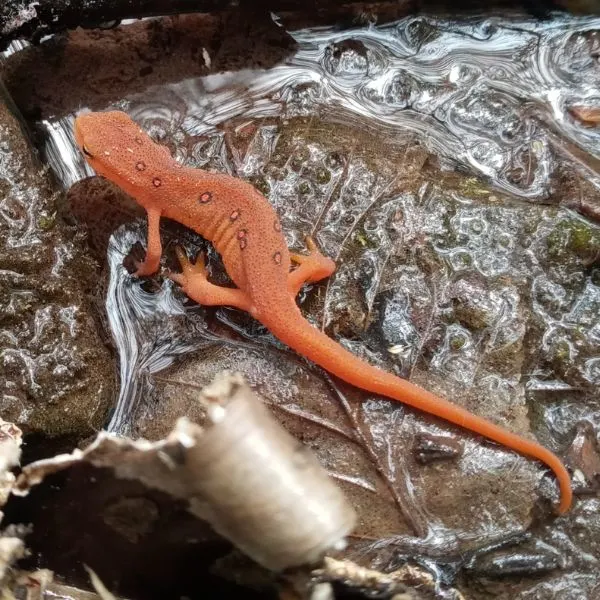
- Scientific Name: Notophthalmus viridescens
- Other Common Names: red eft (as juveniles), eastern red-spotted newt, red-spotted newt
- Adult Size: 2.76 to 4.88 inches (7 to 12.4 cm)
- Lifespan: 15 years
- Population Trend: Stable
- Conservation Statuses: Least Concern on IUCN Red List, S3 (Vulnerable)
This newt is commonly kept as a pet and kept in aquariums. As juveniles, they are bright orange and are known as the red eft at that stage. The adults have dull olive-green dorsa and yellow undersides.
This species is endemic to east Texas. The species isn’t named the eastern newt by coincidence although the common refers to its entire geographic range within North America. This range includes Louisiana, Mississippi, and Alabama.
N. viridescens is endemic to the Gulf Coast area of the southeastern United States. These include the Mobile Embayment drainage system, Alabama, Mobile, Pearl, and Pontchartrain lineages from northeastern Mississippi to the southeastern western lineage of the Gulf Coast drainages from eastern Texas to western Louisiana.
24. Black-spotted Newt

- Scientific Name: Notophthalmus meridionalis
- Other Common Names: Texas newt
- Adult Size: 2.9 to 4.3 inches (7.4 to 10.9 cm)
- Population Trend: Decreasing
- Conservation Statuses: Endangered on IUCN Red List, S3 (Vulnerable)
N. meridionalis is the largest newt of the genus Notophthalmus. The body is olive green with black spots which gives the species its common name. The underside of the species is dull yellow.
The black-spotted newt is endemic to southern Texas. Within the United States, this species is endemic to only Texas. In Texas, the species occurs mainly within the Gulf Coastal Plain south of the San Antonia River. This species also occurs in Mexico, specifically southern San Luis Potosi, northern Veracruz, and Tamaulipas.
Family Sirenidae
25. Greater Siren

- Scientific Name: Siren lacertina texana
- Other Common Names: Rio Grande lesser siren
- Adult Size: 7 to 38 inches (18 to 97 cm), 1.9 to 35.3 oz (1 kg)
- Average Adult Length: 24.4 to 30.3 inches (62 to 77 cm)
- Lifespan: 25 years
- Population Trend: Stable
- Conservation Statuses: Least Concern on IUCN Red List, S2 (Imperiled)
The greater siren is the larger of the two sirens. The siren is brown or black to grey in color with a light-colored underside. S. l. texana is aquatic and retains its gills.
A subspecies of Siren lacertina is endemic to Texas. The subspecies is known as Siren lacertina texana. The subspecies is endemic to south Texas including the Rio Grande Valley. Outside of Texas, the species also occur from the District of Columbia to Alabama and Florida. Within the Rio Grande Valley, the species also occur in Matamoros within the Mexican state of Tamaulipas.
Within Texas, the species occur in Brownsville in Cameron county to Upson in Maverick county.
26. Lesser Siren

- Scientific Name: Siren intermedia nettingi
- Other Common Names: mud eel, dwarf siren, two-legged eel
- Adult Size: 7 to 27 inches (18 to 69 cm), 1.76 oz (50 grams)
- Average Adult Length: 17 inches (43 cm)
- Lifespan: 6 years
- Population Trend: Stable
- Conservation Statuses: Least Concern on IUCN Red List, S5 (Secure)
S. i. nettingi is an aquatic salamander. It retains its gills and several other larval features. This is called the lesser siren as it is usually smaller than the greater siren. The siren is brown or black to grey in color with a light-colored underside. There are individual lesser sirens with dark dorsal specks.
The subspecies which is endemic to Texas is the Siren intermedia nettingi. This subspecies occurs in the southeast and in East Texas. The subspecies can also be found in the Rio Grande Valley.
Outside of Texas, the species is endemic to the Gulf Coastal Plain of central Florida to Virginia. The species is also found in northern Veracruz and northern Tamaulipas – states in Mexico. The lesser siren also occurs in the Mississippi valley in Michigan to Virginia.
In all, the species can be found in Virginia, Texas, Tennessee, South Carolina, Oklahoma, North Carolina, Missouri, Mississippi, Michigan, Louisiana, Kentucky, Indiana, Illinois, Georgia, Florida, Arkansas, and Alabama.
Frequently Asked Questions
What are the amphibians of Texas?
Texas is home to several amphibians. There are about 72 amphibian species within the state. There are about 28 salamander species in Texas. This number may increase as new species get discovered. Similarly, several species are endangered.
Which Salamanders can be found in East Texas?
Many salamander species can be found in east Texas. Some salamanders in east Texas include eastern newt, three-toed amphiuma, marbled salamander, mole salamander, smallmouth salamander, southern dusky salamander, Georgetown salamander, dwarf salamander, Salado springs salamander, western slimy salamander, and western lesser siren.
What are the Texas newts?
There are two newts in Texas. These are the eastern newt which is can be found in east Texas and the black-spotted newt.
Newt vs salamander, What is the difference?
While all newts are salamanders, not all salamanders are newts. Newts are salamanders found within the subfamily Pleurodelinae. The Pleurodelinae belongs to the family Salamandridae.
What is the Austin Texas salamander?
This probably refers to the Austin blind salamander. This is one of the salamanders which is endemic to Austin.
Can you find the marbled salamander in Texas?
The marbled salamander occurs in East Texas from the Gulf of Mexico to the Red River.
Conclusion
There are many salamander species in Texas. In total there are about 28 salamander species in the state of Texas. These include species from the following taxonomic families Ambystomatidae, Amphiumidae, Plethodontidae, Proteidae, Salamandridae, and Sirenidae.
There are quite a number of blind salamanders in Texas. These are generally subterranean and live entirely in darkness. These blind amphibians have reduced eyes underneath a layer of skin. Some such as the Comal blind salamander relies on the change of water pressure called by the flow of an aquifer to sense prey.
Texas is also home to two sirens, an amphiuma, and two newts.
Other nearby states
